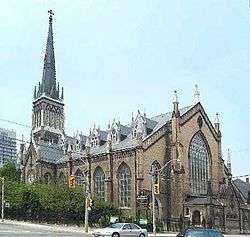Michael Power (bishop)
| Michael Power | |
|---|---|
| Bishop of Toronto | |
| Church | Roman Catholic Church |
| Archdiocese | Toronto |
| Province | Ontario |
| Diocese | Toronto |
| Installed | 1841 |
| Term ended | 1847 |
| Predecessor | None - newly created diocese from Roman Catholic Archdiocese of Kingston |
| Successor | Armand-François-Marie de Charbonnel |
| Orders | |
| Ordination | August 17, 1827 |
| Personal details | |
| Born |
October 17, 1804 Halifax, Nova Scotia |
| Died |
October 1, 1847 (aged 42) Toronto, Canada West |
| Buried | St. Michael's Cathedral, Toronto |
| Nationality | Canadian |
| Residence | Toronto |
| Parents | William Power and Mary Roach |
| Occupation | Bishop of Toronto |
| Alma mater | Seminary of St. Sulpice, Montreal and Seminary of Quebec |
Michael Power (October 17, 1804 – October 1, 1847) was the first Roman Catholic Bishop of Toronto.
Early years
Born in Halifax, Nova Scotia, Canada to Captain William and Mary Roach Power, immigrants from Waterford, Ireland. At the age of twelve he was sent to the Seminary of St. Sulpice, Montreal and completed his training at the Seminary of Quebec. He was ordained a priest on August 17, 1827 by Bishop John Dubois of New York.[1] He served as missionary priest of the Archdiocese of Québec and the Diocese of Montréal. Father Power was appointed pastor at Drummondville, where he remained until 1831 when he was sent as pastor to Montebello. From 1833 to 1839 he was pastor of Sainte-Martine, near Valleyfield. In 1839 when he was appointed Vicar General of Montréal.
First Bishop of Toronto
The diocese was created on December 17, 1841 out of the Diocese of Kingston. Father Power was appointed the first Bishop of the new See, and consecrated in 1842 in Laprairie, Quebec, by Bishop Rémi Gaulin of Kingston.[1] Power was the first English-speaking Bishop to be born in Canada.
Bishop Power immediately drew up rules for the diocese, which were adopted by the clergy. During the course of his episcopate he had to cope with several unworthy clerics and did not hesitate to threaten and apply harsh punishment. In the autumn of 1842 he asked the general of the Jesuits for men to assume direction of the Indian missions in the western and northern parts of his diocese. They arrived the following July and established their base in Sandwich. Between 1843 and 1845, he visited the various areas of the diocese. In 1844, Power and other Canadian bishops successfully petition the Pope for the creation of an ecclesiastical province in Canada. The dioceses of Quebec, Montreal, Kingston and Toronto were united under the metropolitan Province of Quebec, and Quebec became the Archdiocese.[1]

On May 8, 1845, Bishop Power laid the cornerstone for St. Michael's Cathedral.[2]
In January 1847 Power left on a six-month visit to Europe, seeking to recruit additional priests and to raise money for his cathedral. While in Ireland he arranged for the Sisters of Loreto to establish a mission in Toronto. He also witnessed the famine that was driving unprecedented numbers of Irish to emigrate.[3]
Death
More than 90,000 landed at Quebec in 1847 to escape the Great Famine. Typhus was rife among them and spread to the Canadian towns, including Toronto. Power contracted the disease while calling on some of the victims and succumbed to it on 1 Oct. 1847. He was 42 years of age. Power's remains are buried in a crypt beneath St. Michael's Cathedral.
Legacy
A sculpture of Bishop Power, created by John Cochrane, is located at the main entrance the archbishop's residence in Toronto.
Bishop Power's most notable achievements were the building of St. Michael's Cathedral, Toronto and the Bishop's Palace on Church Street.
In 2005, Mark G. McGowan wrote a book called, Michael Power: The Struggle to Build the Catholic Church on the Canadian Frontier.
In 2009, Bishop Power was featured prominently in the docudrama Death or Canada, which tells the story of the Irish Famine and its impact on Toronto in 1847. Power is portrayed as the hero of Toronto and is described as a "martyr of charity."[4] A contributor to the film, Mark G. McGowan also wrote a book, Death or Canada: The Irish Famine Migration to Toronto, 1847.
References
- 1 2 3 Nicolson, Murray. "Michael Power First Bishop of Toronto", CCHA, Historical Studies, 54 (1987), 27-38
- ↑ Pound, Richard W. (2005). 'Fitzhenry and Whiteside Book of Canadian Facts and Dates'. Fitzhenry and Whiteside.
- ↑ Choquette, Robert. "Power, Michael", Dictionary of Canadian Biography, vol. 7, University of Toronto/Université Laval, 2003
- ↑ "The Catholic Register - The story behind the Irish invasion of 1847". Retrieved 2009-03-20.
Further reading
- "Michael Power". Dictionary of Canadian Biography (online ed.). University of Toronto Press. 1979–2016.
- Mark G. McGowan. Michael Power: The Struggle to Build the Catholic Church on the Canadian Frontier (2005)
| Religious titles | ||
|---|---|---|
| Preceded by |
Bishop of Toronto 1841–1847 |
Succeeded by Armand-François-Marie de Charbonnel |